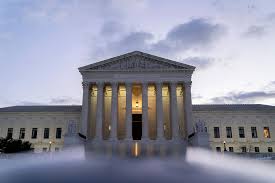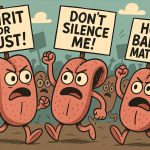I wrote this essay while I was on retreat in early July but, for reasons that will become clear by the end, chose not to post it here until now.
Except for those who deliberately and religiously stay disconnected from current events and those who live under a rock, everyone in this country knows that the United States Supreme Court overturned the 1973 Roe v. Wade decision in June, thus overruling fifty years of precedent and abolishing the right to an abortion as federally guaranteed, turning things back to the states to do what they will. Five of the six justices voting in the affirmative to uphold the Mississippi law in question and overturn Roe did so with confidence and not a little condescension, while the three dissenting justices were equally confident that their affirming colleagues had gone off the rails and had wandered far from their judicial duties in the interest of partisan politics.
After reading the 200+ pages of opinions both affirming and denying, it is not surprising that I was offended by much of the majority’s argument and was in full agreement with the outrage expressed by the minority. I am, after all, strongly pro-choice on the abortion issue. What remains with me most, however, is the “opinion concurring in the judgment” filed by Chief Justice John Roberts. The description of his opinion means that he concurred with upholding the Mississippi statute but disagreed with the majority’s reasoning to support doing so.
In Roberts’ estimation, given the importance of stare decisis (a strong respect for precedent), the court should have sought a way to uphold the Mississippi law without overturning Roe. Roberts then proceeds to describe how this could have and should have been done. Roberts’ opinion is a case study in how to thread a needle judicially, how to decide a case solely on the evidence presented without doing more or less than necessary.
Be that as it may, what caught my attention, and what I can’t get out of my mind weeks later, is what appears to be an almost throw-away sentence in the next to last paragraph of Roberts’ opinion.
Both the Court’s opinion and the dissent display a relentless freedom from doubt that I cannot share.
After all of the arguments from all sides, after the vitriol and name-calling disguised in formal legal language with footnotes and citations, Roberts is observing that his eight companions on the Supremes actually shared something important in common. All eight of them were absolutely and completely convinced with certainty that they were right. Which means that those who disagreed with them were absolutely and dead wrong.
If you are a regular reader of this blog, you know that I write about the importance of establishing doubt as an important piece of one’s belief arsenal and that certainty is overrated on a regular basis. So on one level, Roberts is agreeing with me—seeking relentlessly to be free of doubt is both a common and a destructive activity. But he is also sending a shot across my bow because I entertain no doubt concerning my position on the abortion issue. I am certain that this majority decision was a bad one, just as certain as the three dissenting justices were. I am certain that my pro-choice position is so much better than various pro-life stances that I assume pro-life people must have some agenda other than what they state. I am relentlessly free of doubt on this issue. just as those who believe entirely differently are.
And this is a problem. I am accustomed to being the guy who often says “but I might be wrong” or “but I have a lot to learn” about what I believe, the guy who encourages others to be similarly open-ended and wary of certainty. But on this particular issue (and perhaps a couple of others) I think I have it right, don’t have any room for change, and am judgmental and dismissive of those who disagree with me. This has suddenly come under some pressure this summer when an unexpected request came from our college president.
The rough draft of Justice Alito’s majority opinion overturning Roe v. Wade was leaked to the public during finals week on my campus last May. I teach at a Catholic college (roughly two-thirds of our students are Catholic); not surprisingly, the Chaplain’s office sent an email out inviting people to gather in the chapel to pray both in thanks for the likely overturning of Roe v Wade and in hopes that the overturning would actually happen. Many (including myself) read the email as somewhat tone deaf, both triumphalist and dismissive of those who might think overturning Roe is a bad idea. A small group of students protested outside the chapel while the prayers were going on inside. Some wrote slogans and statements of protest with chalk on the patio outside the chapel doors, including “Keep your rosaries off my ovaries” and “So much for celebrating women at Providence College” (2021-22 was the 50th academic year anniversary of women being admitted to Providence College).
Not surprisingly, the President of the college sent a lengthy email to the campus community a couple of days later which, although more temperate than the previous email from the Chaplain’s office, still struck many on campus as problematic. On behalf of numerous faculty who expressed dismay in various ways, I wrote a similarly lengthy email to the President expressing my concerns. Given my previous experience with the President, it did not surprise me that I immediately received a return “thank you” email from him, expressing interest in organizing a campus-wide conversation on abortion and related issues in the upcoming fall semester.
Because no good deed ever goes unpunished, I was invited soon afterwards to be part of a four-person planning committee that would meet over the summer to plan this Presidentially sponsored event. The four faculty members on the committee represent the spectrum of positions on the abortion issue from pro-life to pro-choice; our conversations with each other and the president over the summer began by focusing on what we want this planned event to achieve. Clearly we don’t need or want an event where people from each side of the issue shout each other down, confident in their ethical superiority over the moral troglodytes on the other side. In other words, we don’t want this event to be what we have all come to accept as the norm in our polarized culture when controversial issues are being “discussed.” But what do we want this event to achieve?
A good friend of mine gave the homily at church a few weeks ago. She began her sermon by listing a few of her mother’s favorite sayings during my friend’s childhood years. A couple were very familiar, such as “If it had been a snake, it would have bit you.” But one of the sayings was one I had never heard before: “Begin how you want it to end.” She used the phrase to distinguish between justice and mercy, important but entirely different aspects of the life of faith, both of which are listed in Micah’s observation that what the Lord requires of us is to do justice, love mercy, and walk humbly with God.
As I listened in my pew to my friend’s sermon, I began thinking about the first few meetings of the planning committee for the event in the fall. One of my colleagues, who happens to be on the opposite side of the abortion issue than I am, imagined an event in which students would, at the end, have learned that it is possible for people of good faith who disagree strongly about important issues to listen, discuss, and debate intelligently without there having to be winners and losers. My colleague envisioned an event designed not to convince anyone of any particular position, but rather to demonstrate that it is possible to dialogue about difficult topics and remain both civil and members of the same community.
Everyone at the meeting resonated with my colleague’s vision, especially since what was being imagined is almost non-existent in our polarized culture. So if that’s how we want it to end, then that’s how we needed to begin. Choices about participants, moderators, the structure of the event, and questions shaping the discussion all have been made with our end in view. Our summer conversations have been shaped by this commitment—the challenge is to have a civil and constructive conversation in public on arguably the most controversial and polarizing issue in our country.
In one of our meetings I told my committee colleagues a story from 25 years ago when I was a new untenured junior faculty member at the college. I was teaching an applied ethics course in the evening school, a course that covered a number of controversial topics, including abortion. Someone probably should have advised me not to cover the abortion issue in class as a junior faculty member at a Catholic college, but I probably wouldn’t have listened to the advice anyways.
One of my students was a young diocesan Catholic priest who always sat in the front row and always wore his collar. The abortion issue was the final topic of the semester. I remember nothing about how the actual classes went, but I do remember that this young cleric came up to me after the final class to thank me. “I haven’t changed my position on abortion a bit—I’m still strongly pro-life,” he said. “But I’ve learned a lot from our discussions. The most important thing I’ve learned is that both sides have very strong arguments.” If that’s what people walk away with from our upcoming event, we will have been successful.
The college President announced this event at Convocation yesterday–it will take place in early October. Thoughts and prayers are welcome.













